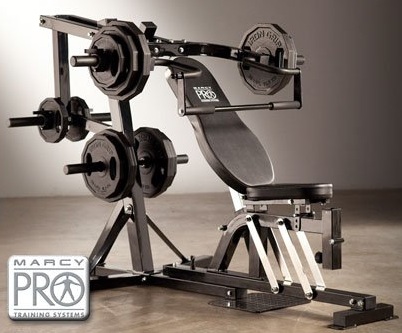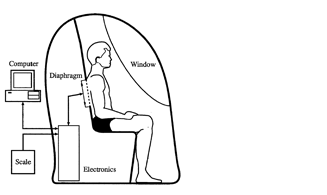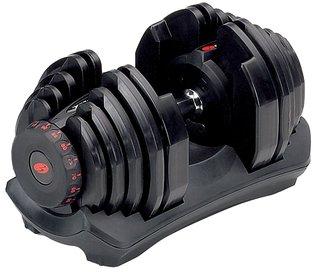Applying least resistance to gaining muscle
The least-resistance philosophy dictates that you should mold your environment so that the path of least resistance is the path of maximum productivity.
The core principles are eliminating barriers to engaging in productive behavior and erecting barriers to engaging in counter-productive behavior.
Admittedly, this philosophy is tricky to apply to an activity that stresses reaching "maximum resistance."
But, the principles still work.
Going to the gym is a major transaction cost.
Putting on gym clothes is a barrier.
Finding a consecutive block of time to work out induces opportunity costs.
If you set up your equipment at home so that you can walk in, do a set and walk out, you are at the gym whenever you're home.
There are mixed opinions as to whether concentrated or dispersed exercise leads to faster muscle growth.
Whatever the case may be, it is clearly the case that both styles work.
[In my case, I break up exercise across 3 to 10 sessions each day. A common pattern for me is morning, after work and before bed. As a result, I don't need 30 consecutive minutes a day. I can scavenge the dead time between activities for lifting.]
The key to success is choosing compact equipment with low per-use overhead that can still target any muscle group with an arbitrary load.
If you make exercise easy and accessible, you are more likely to exercise.
Why muscle grows
Before I did anything, I did some research.
I looked for consistent advice backed by the scientific literature.
A few core principles emerged:
- To gain weight, you must eat more calories than you burn.
- When you gain weight, some will be fat and some will be muscle.
- To gain muscle, you must eat protein.
- To boost the ratio of muscle to fat gain, you must exercise.
- To gain muscle and strength, you must engage in resistance exercise.
- To prioritize strength over size gains, aim for 2-6 repetitions per exercise, where failure occurs on the last repetition.
- To prioritize size over strength gains, aim for 8-12 repetitions per exercise, where failure occurs on the last repetition.
- To maximize gains per unit of exercise, do not work the same muscle group two days in a row.
There are a few corollaries to these principles:
- To continue gaining strength, you must increase resistance.
- To optimize strength and size gains, vary repetitions over time.
- To improve bodyfat percentage and gain weight, you must cycle through phases of gaining muscle and losing fat.
- Rest thoroughly.
A word on the scientific literature
The scientific literature on fitness varies in quality and, at times, misleads.
There are many seemingly contradictory findings about the (non-?)importance of protein, resistance exercise, supplements, etc.
Two problems plague the literature:
- Sample sizes too small to draw meaningful conclusions.
- Subsequent misinterpretations of statistical significance.
There are articles cited as evidence that "X does not improve muscle growth," where upon further inspection, the data might actually show a positive correlation between X and muscle growth.
Because the finding was not "statistically significant," it was misinterpreted as "there is no correlation."
A lack of "statistical significance" does not mean there is no correlation.
A lack of "statistical significance" means the sample size was too small to render judgment at the desired level of confidence (usually chosen by the experimenter somewhat arbitrarily to be 90%, 95% or 99%).
The presence of a correlation but a lack of statistical significance should be interpreted as "preliminary research is promising, but more experimentation is needed to render judgment."
The bottom line is that you must interpret the data yourself.
For a humorous (and enraging) primer on the misuse of statistical significance
in science,
I recommend Ziliak and McCloskey's
The Cult of Statistical Significance:
Form the habit first
Initially, developing an exercise habit is more important than the specific exercise you do.
Do push-ups, weights, sit-ups, jogging, cycling, pull-ups or whatever.
At first, it doesn't matter.
You need the habit so that when injury strikes or travel interrupts, you know you'll go back to your routine.
Do it on three non-consecutive days a week for about half an hour.
Bodyweight exercises are good enough for building the habit because they don't need any equipment. The transaction cost to exercise is near zero.
A
detachable pull-up bar
is a cheap and effective way to expand your options with bodyweight exercises:
Diet
Gaining weight, whether fat or muscle, requires over-eating.
To gain a pound of muscle or fat takes over-eating by about 3500 calories.
It's challenging to gain even a 50/50 ratio of muscle/fat, so be sure to supply your body with protein on all days to capture the lasting effects of resistance training as a stimulus to muscle growth.
There's a mixture of opinions as to whether the timing of protein ingestion matters, and to what extent it matters if it matters.
There are claims and counter-claims that the body can absorb only up to 30g of protein "at a time."
I never resolved these debates.
I recommend eating protein with every meal, and before and after exercise.
Eating six meals stretched across the day probably does improve muscle growth at the margins, but it is certainly inconvenient and, in my experience, unnecessary.
Recommended amounts of protein vary from 0.8 grams per kilogram of bodyweight per day to 2 grams per kilogram.
I aimed for roughly 1.5 grams per kilogram, but not stringently.
Whey protein makes it easy to hit the target
you set:
I use hydrolized whey, since it is "pre-digested." It absorbs rapidly and avoids some of the socially problematic "side effects" of high-protein diets.
Whey is a complete protein: it contains every essential amino acid, and beyond that, it is an abundant source of the branch-chain amino acids critical to muscle growth.
A blender bottle avoids the need for a blender (thereby lowering transaction costs to consuming protein), and makes a shake with water or milk:
It takes about a minute to make a shake, drink it and rinse out the bottle.
MyFitnessPal makes it easy to track calories and hit a 500 - 1000 calorie surplus on workout days, and a 200-500 calories surplus on rest days.
Track your weight carefully, and adjust your surplus as needed.
An RMR calculator can estimate daily caloric expenditure.
Routines
Since rest is important to growth and healing, lifting on consecutive days is sub-optimal from a growth per unit of exercise perpsective.
It also increases the likelihood of injury.
There are routines that lift on consecutive days. These achieve rest by hitting strictly different muscles on consecutive days.
Find the split that works for you.
If you're looking for a starting point, BodyBuilding.com's workout planning page has a variety of plans based on specific goals.
In my current routine, each day has a different upper-body theme: arms; shoulders and back; and chest. I do a few leg exercises on each lifting day.
I saw good results on just 3 days a week.
I'll consider a new routine if I plateau and still need more strength.
While gaining weight, I aim for about 20 sets of 8-12 reps to failure.
While cutting fat, I aim for about 15 sets of 4-8 reps to failure.
Listen to your body.
If it can handle more sets, do more sets. If you're sore days later, do less.
On each lifting day, pick an assortment of exercises that target the muscle group for that day, with some variation week to week.
Dumbbells first
Dumbbells are a great way to tiptoe into resistance training, because they're a versatile piece of resistance equipment, and they're relatively safe.
From a least resistance perspective, their real strength, however, is their compactness and low transaction cost.
That ease of use is why I moved to dummbells after bodyweight.
Anyone can fit dumbbells in their home or office.
I began with a simple,
40-Pound adjustable dumbbell set:
but these are poorly suited to a least resistance approach because it takes about two minutes to unscrew all four caps and change the plates each time.
And, my small workout room filled with plates as I gained strength.
I borrowed a
PowerBlock Elite set from a friend:
To select a new weight on these, you pull and re-insert a two-prong peg on the side. It's a much lower transaction cost than cap-and-plate dumbbells, but you do have to crouch down to face the side and get both pegs to line up. It takes about 10-20 seconds to adjust each one.
Aiming to entirely eliminate that per-lift set-up time,
I bought two
SelectTech 1090 adjustable dumbbells:
With the flip of the dials, these select between 10 and 90 pounds per hand in 2.5 pound increments.
I wish I'd had these at the start instead of the cumbersome cap and plates.
To reduce the transaction cost to engaging in exercise, I mounted them on the
SelectTech dumbbell stand
in a room about the size of a walk-in closet:
When they were on the floor, the cost of engaging in every dumbbell exercise was an implicit deadlift.
After a month of dumbbell exercises,
to increase the range of exercises I could do, I added
an adjustable bench
to my setup:
It takes about 20 seconds to set up and begin any exercise.
My favorites dumbbell exercises are:
- Flat chest press.
- Seated overhead shoulder press.
- Chest fly.
- Hammer curls.
- Overhead tricep extension.
- Lateral raises.
- Upright rows.
- Weighted lunges.
- Weighted calf raises.
Of course, there are dozens more you can do with dummbells.
BodyBuilding.com has 123 different dumbbell exercises.
Try them all (or the ones that look fun to you).
Safety
Even with dummbells, I was able to put loads on my back that felt uncomfortable within about three months.
As a precaution, I bought a
lifting belt
to stabilize my core
on these lifts:
I also found it easy to put loads on my wrists that coupled with my propensity for typing all day started to cause some pain.
Padded lifting gloves with wrist support helped keep my wrists in a stable, safe position and alleviated wrist pain.
It's helpful to schedule at least one session with a personal trainer to review proper form. You can only learn so much from YouTube videos.
Pressing
About five months after I started lifting, I hit 90 pounds per hand on the flat bench press (up from 25 per hand at the start).
To increase resistance on the bench press, I had to buy a pressing system.
I considered a traditional barbell system.
While I enjoy using barbells in hotel gyms, safety was my prime concern, and I had no one at home to spot me with a traditional barbell.
Eventually, I picked the Marcy PRO Compact Strength Trainer:

This system is small and it fits in the same small room as my dumbbells.
Critically, it is impossible to crush yourself with this system.
From a least resistance perspective, the per-lift transaction cost is very low after the weights are adjusted for the first lift of the day.
It accepts standard olympic plates up to 500 pounds, so it should be good for a lifetime of lifting needs for the average person.
It supports performing many compound lifts safely and quickly.
It won't engage the stabilizers as well as a traditional barbell, but I was willing to make the sacrifice for safety and efficiency.
The relative position of the handles and the plates does create a 3:2 mechanical advantage, e.g., 300 pounds of plates yields 200 pounds of resistance.
If you're willing to tolerate some additional transaction cost and have a workout room larger than a walk-in closet, you can lift safely with a barbell and power rack, and that will engage stabilizers.
Cutting
There is no way to avoid gaining some fat while building muscle.
As a result, it will be necessary to periodically "cut" fat.
Rest days are critical while cutting and injuries take longer to heal.
Strength gains (except for nervous system adaptations) are unlikely during cutting, so the goal is to maintain rather than gain strength.
If your strength is stable (or decreases only slightly) during a cut, you are preserving muscle and cutting fat.
If your strength is dropping quickly, you may be cutting too fast.
1.5 pounds per week is widely recommended as a safe amount to cut.
Be sure to continue protein supplementation so that the body does not have to break down muscle to meet its nutritional demands.
I've found no harm in aerobic exercise on non-lifting days while cutting.
Supplements
There are countless supplements available that purport to help.
Supplements have the biggest effect when they correct deficiencies.
I've experimented with many, but only a handful had a noticeable impact.
Before trying anything, I recommend checking it out on examine.com first. The site has thoroughly reviewed the scientific literature on almost every supplement you'll encounter.
Whey protein
Whey protein does not have an immediate impact on strength, but it does make it easy to hit protein targets and maintain steady gains.
It is notable for its fast rate of absorption by the body, and its high concentration of amino acids critical to muscle protein synthesis.
These days, I strictly prefer
hydrolized whey:
since it absorbs rapidly and has no socially problematic "side effects."
I did have great results early on with
a
whey isolate blend:
But, I had to take it with psyllium husk fiber every time.
Or else.
Creatine
In terms of impact,
creatine
stands out.
With one teaspoon a day:
I saw exceptionally rapid gains in strength for several weeks.
Discontinuing creatine did not cause a reversal in strength.
Creatine does cause water retention.
Hydration is critical to avoid cramps.
Discontinuing creatine will also end the water retention, resulting in temporarily rapid "weight" loss.
Branch-chain amino acids (BCAAs)
After creatine, branch chain amino acids stand out as useful for blunting hunger and fueling muscles while cutting or fasting.
Small amounts of BCAAs (up to 20g) do not seem to interfere with the benefits of fasting.
There is no need to take BCAAs simultaneously with whey protein, since whey protein contains all three BCAAs.
If you take BCAAs, I recommend the
BCAA capsules, since the powder tastes wretched:
Casein protein
Casein protein
is a complete protein
useful for its uniquely slow rate of absorption:
I don't use it currently, but in the past I used it after my last workout or before bed to provide a steady trickle of protein all night long.
I have also used it to dampen hunger right before a fast.
I discontinued its use not because it was ineffective, but because I felt that micromanaging my proteins at this level was cutting against the least resistance philosophy.
To simplify, I use only whey for protein supplementation.
Vitamin D
Programmers, by nature, tend to have lower sun exposure and lower levels of vitamin D.
Vitamin D deficiency can cause low testosterone.
Modest supplementation with
vitamin D
can correct that and raise testosterone:
Or, you can go outside more often.
Dealing with injury
Good form and adequate rest will help avoid injury.
But, when an injury happens during a workout, end the workout.
Exercise on that body part is suspended until recovery.
It's tempting to "power through" an injury.
Just don't do it.
If treated quickly, minor injuries will heal in a day or two.
Taking an entire week off from exercise every couple months also gives your body a chance to fully recover from accumulated stress.
Measuring progress
Keep a spreadsheet to track 1, 5, 8, 10 and 12 rep maximums.
For each exercise, record the weight at which the muscle fails for the given number of reps.
Track maximums to ensure progressive overload.
If you hit 12 reps, it's time to increase the weight.
Track values like cholesterol, blood pressure, blood glucose and triglycerides annually or semi-annually, as these values may rise while gaining weight.
I was able to track my bodyfat percentage using a "bod pod" at the university health science center:

Tracking bodyfat percentage is important because you can compute how much you're gaining as fat and how much as lean mass.
According to bod pod measurements, about 14 pounds of my weight gain over my first year of lifting was lean mass.
Close to 20 pounds of what I gained was fat.
I've carefully dropped 10 pounds since then, losing one pound of lean mass and nine pounds of fat in the process.
The next time I start gaining, I can safely lower my caloric surplus.
My 10-rep bench press went from 50 pounds to 220 pounds in one year.
[After accounting for mechanical advantage, my 10-rep bench press on the compact trainer I use at home was about 250 pounds.]
I had 3x-5x improvements in lifts across the board.
Due to diminishing returns, I will not be able to add 14 pounds (or even 10 pounds) of muscle and that much strength over the next year.
Initial gains are much easier, and I was starting from a very blank slate.
But, at this point, it doesn't matter.
I can already lift my son and his wheelchair up a flight of stairs.
External resources
- BodyBuilding.com's workout planning page contains a variety of routines and plans depending on your fitness goals. (They're not all dedicated to bodybuilding.)
- The fitness subreddit was really inspirational to me early on, and its FAQ is excellent.
- I've also enjoyed lurking on the advanced fitness sub-reddit lately.
- Examine.com is an excellent resource on supplements.















